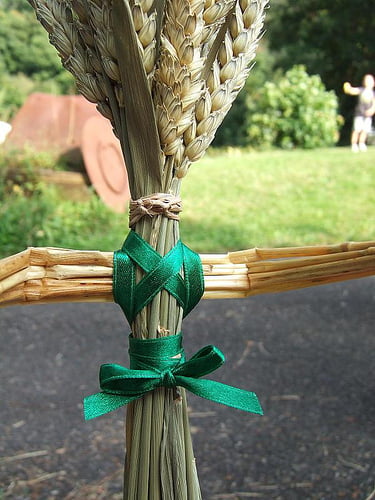
August brings the sun’s rays and Lammas
As the summer sun climbs higher in the sky, and the earth is warmed by its strong rays, we seek the cool indoors or under a shade tree. Gardens are bursting with healthy vegetables and fruits such as vine ripened tomatoes, and the first of the wheat and corn are being harvested. The fragrance of fresh herbs fills our kitchens. The aromas of sweet basil and thyme drift and freshly picked spearmint is ready for our afternoon iced tea. These are the days of summer when we gather the first of the harvest and enjoy the bounty the earth has provided.
August 1 marks the harvest in our lives, and in our fields and gardens. Scott Cunningham writes, “At this time of year, we should be harvesting the fruits of our actions during the past year, reflecting and musing 2008).”

Freshly baked bread. Photo credit: mystuart / Foter / Creative Commons Attribution-NonCommercial-NoDerivs 2.0 Generic (CC BY-NC-ND 2.0)
“Lughnasadh, or Lammas (as the Catholics renamed it in an attempt to Christianize the old Pagan festivals), was a festival of bread; thus, bread-making is traditional at this time of year (Cunningham & Harrington, 2008).”
Lammas is the celebration of the harvest and the Corn Mother, so it is the celebration of the Grain God wholes life is sacrificed at the harvest. Some of the most ancient Gods, Tammuz, Adonis, Attis and later Dionysus, were vegetation and grain Gods. As the Goddess is eternal, ripening and aging and sleeping through the winter to be renewed and become the Maiden once again. It could also be the Goddess descending into the Underworld alive to find her beloved consort who has died; and so the God must die in order to be born again (Campanelli, 1992, pg. 129).
Another name for Lammas is Lugnasadh (or Lugnassad) named for the ancient Celtic Sun God Lugh. It was not his life being celebrated, however, but his death being mourned that many of the old Rites commemorated. Lammas follows Midsummer when the Sun is at its height of power, and marks the time when the darkness begins to wax as the light of the sun wanes.
We remember the Goddess through symbols, foods, and rituals. During Lammas, we may take time to make corn dollies. These are beautiful, creatives figures of braided and plaited wheat straws or corn husks.

Corn dolly made of wheat. Photo credit: crunchcandy / Foter / Creative Commons Attribution-NonCommercial-NoDerivs 2.0 Generic (CC BY-NC-ND 2.0)
“Originally, such corn dollies, or kirn babies, were made from the last sheaf of reaped wheat. The stems were braided together to make a symbolic human shape which is the personification of the Mother Goddess of the harvest. These treasures remained in the lucky house for a year, guarding it, until the dolly was destroyed and a new one fashioned (Cunningham & Harrington, 2008, pg. 142).”
Other Lammas Traditions
In addition to fresh-baked bread, families traditionally baked berry pies on Lughnasadh in honor of the harvest. Around the home, you can decorate with bowls of fruit and baskets of vegetables.
The practice of hermetically sealing jars, which is what canning does, actually began as a magickal process. It is attributed to Hermes Trismegistus, the Greek name for the Egyptian God Thoth. A simple ritual to ensure the jars will seal when canning fresh food such as the newly harvested tomatoes, peaches and berries. First wipe the top rim of the jar with a hot, clean sponge before placing the lid in position and screwing down the rim. Then with the tip of your finger, inscribe a pentagram on the lid, saying words like (Campanelli, P., 1992) Lid seal – protect this meal.
Days Ahead…
While August brings the abundance of the harvest, we also sense an urgency to prepare for the leaner days ahead. Braids of onions hang from the rafters of the wood shed. Red tomatoes are being crushed and steamed for canning. Berries picked and washed are finding their way to breakfast bowls while some are being prepared as jam to be placed in their glass jars for the coming winter. It is a busy time of year for some, but we remember through our rituals and place importance on our preparations for winter.
References
Campanelli, P. (1992). Ancient ways: Reclaiming Pagan traditions. Llewellyn Publications. St. Paul, MN. 2nd Printing.
Cunningham, S. and Harrington, D. (2008). The magical household. Llewellyn Publications, Woodbury, MN. 24th printing.
Fresh baked bread. Photo credit: mystuart / Foter / Creative Commons Attribution-NonCommercial-NoDerivs 2.0 Generic (CC BY-NC-ND 2.0)
Corn dolly made of wheat. Photo credit: crunchcandy / Foter / Creative Commons Attribution-NonCommercial-NoDerivs 2.0 Generic (CC BY-NC-ND 2.0)

From one follower of the Goddess to another thank you for another beautifully written article and for taking the time to follow my blog at http://psikeep.wordpress.com
Thank you so much for your kindness. Be well lorenwolf!